The Favourite's Production Designer Explains How They Managed to Film with All Those Rabbits
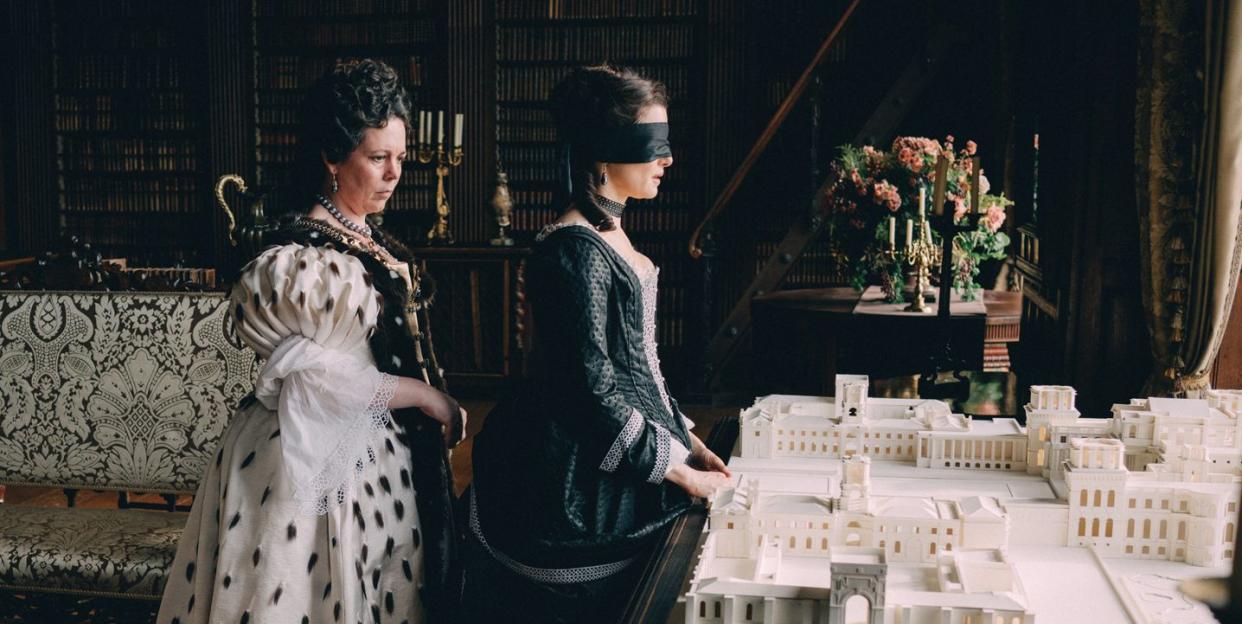
The Favourite is no staid period piece. There's a duck race, debilitating gout, and a dancing scene so bizarre it'd be out of place in a conceptual art show. And yet, it ostensibly takes place in a centuries-old royal court, gilt finishings and powdered wigs and all.
How could one possibly design one world to house both ends of this extreme spectrum? Production designer Fiona Crombie had a few ideas-and they seem to have worked quite well. Just this Sunday, Crombie took home the BAFTA for Best Production Design, and she's up for the Academy Award next.
Below, Crombie illuminates her process, from the lengths she went to design a contained rabbit world, to the struggle of filming in a working historical palace.
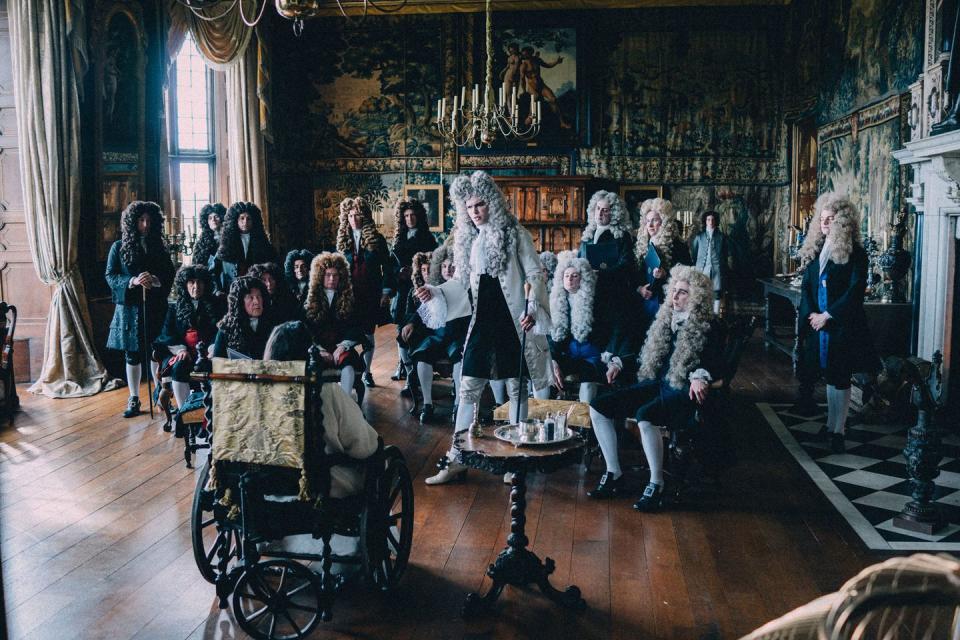
When you first read the script, what kind of scenery did you envision creating for it?
There’s this really anachronistic vibe. Like there’s a lot of things that I knew were inventions, both by the screenwriter and by Yorgos [Lanthimos], the director.
And so there was something immediately quite freeing about reading those words, and reading those screen directions. I guess in my mind I was being given a real license to play.
What was it like working with Yorgos Lanthimos?
We landed quite quickly on some important concepts, one of which was a degree of emptiness, and space, and a real play on scale with certain objects. Basically we set out a set of rules and parameters. That he needed the camera to be able to move, he needed to be able to roam the spaces. He also wanted to be able to see every single inch of those spaces, to be able to look up, look down, turn around; you know, constantly be able to move the camera. So once I understood what his requirements were, he pretty much left me to my own devices. He just trusted that I was gonna do it, really.
Yorgos was involved in the big conversations, like palette-deciding to strip out color and to really be very concise with our palette. But he just let me run with how I decorated the rooms, and what the elements were that we brought in. He would just come in and nod, and touch something, and that was it.
It’s kind of surprising, because sometimes directors really they need to check that everything’s the way they envisioned it. But Yorgos was extremely trusting.
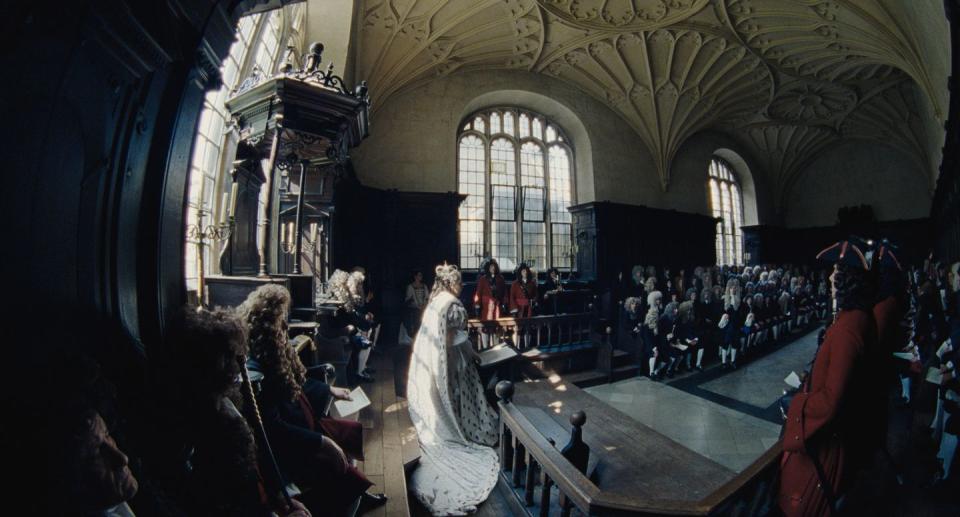
With a trusting director and the permission to play around, what sort of liberties were you able to take?
A lot of it was just in the detailing, to be honest. I was able to put in a lot of details that frankly just amused me. So for example, we really detailed the rabbit world, and put lots of little miniature jugs... They had micro herbs, and little carrots. We did lots of detailing and things like that, just because it was fun to do.
Could you say more about the objects you created for the rabbits?
Well, we decided they should be almost like a doll's house world. So when we designed the cages, I had little wooden floors made that looked like miniature diamond floors. We had miniature jugs and little silver dishes. Anne had little brushes to be able to do grooming. It was just this idea that they were like her children. They represent her children, and they’re a little sort of escape for her. A little world to create.
Again, the whole way through we really enjoyed the play on scale. So there’s the huge bed, and then there’s tiny elements, like the rabbit world. The whole way through the film, the thing that I’m most proud if is that we paid attention to detail, not only in the wide shot, but also in the close-up. Every element that we brought into the set was very considered and handmade, or told a little story. And we really enjoyed that.
I imagine rabbits can be pretty messy. Did you have to design around that?
Yeah, absolutely! We had to have little absorbent covers made. You know when they’re climbing all over that bed-they could not ruin that bed frame. So we had incontinence pads sewn into gold fabric so that they could climb all over the queen and not ruin her costume. They’re quite leaky, rabbits. I hadn’t realized that until we worked with them.
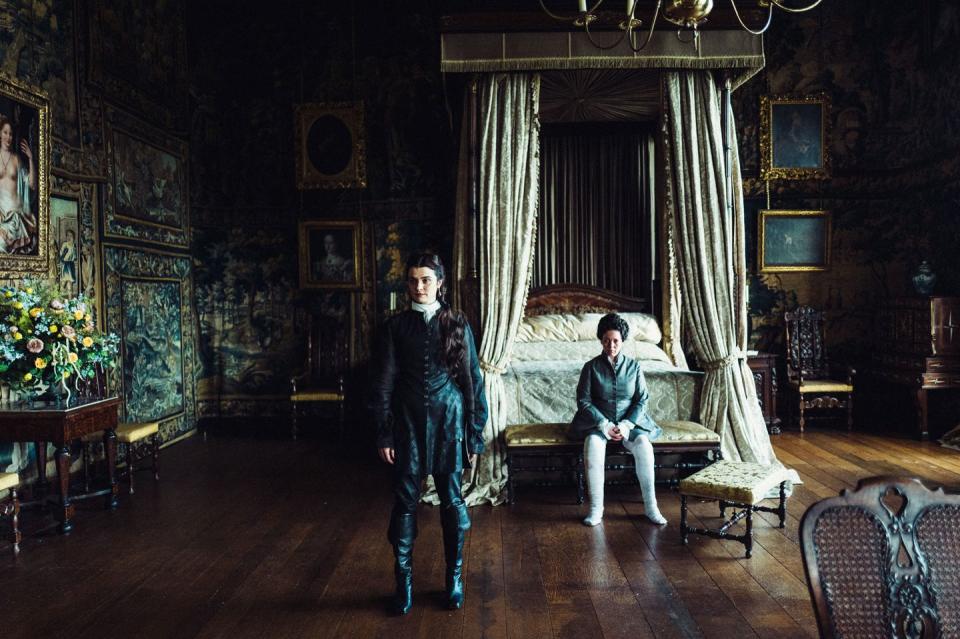
And then there's that scene where the characters are throwing oranges at that naked man. I imagine filming that might've been an issue in a historic home?
Yeah, I initiated that we had to have that screen [behind them]. I mean you can’t say to actors, “listen, can you just not throw it at that priceless piece of art that we have over there, or this beautiful vase.” You can’t ask them to do things like that because it just takes them out of their performance. So we built that screen that we had some kind of control. But it’s also the classic thing that they’re actually not oranges. They’re all prop makes, of course. You know there’s that look, but they’re like just sponges, basically. So yeah, a bit of trickery there.
Obviously Hatfield House has been used as a set in many films before The Favourite, but it wasn’t recognizable onscreen. How did you make it feel different?
I hadn’t ever knowingly seen it in another film. And so I didn’t come with any sort of baggage about "oh, I’ve gotta change this." I just approached it from the perspective of what would be right for our film. It wasn’t until we started working there that, you know, you suddenly start seeing it everywhere. I would turn on the television, and suddenly there it is! It became like "oh, my god, it’s Hatfield House again." What was really gratifying for me was that people have said to me, "you know, I made a movie there, and I didn’t recognize it." And that’s obviously what you want to hear.
Did you bring of your own things to Hatfield House?
We emptied every room, which was a very labored process. Everything had to be archived; they had to bring in art handlers; we had to have special containers built to house their art. So it was very slow, but they allowed us to empty the spaces. And then on top of that, we did construction within each space to bring it into our story. I feel like our work in Hatfield to some extent is quite invisible, and deliberately invisible. We wanted to use the bones of that building and then create our version of an 18th century royal court.
It’s complicated because for me, I was bridging an invented world, and creating a world-setting a stage for this kind of story where there can be duck races and lobster races, and all of that, but also grounded in a built space. It was quite a balancing act. I didn’t want to push too far in one direction, I didn’t want it to be naturalistic, or feel too staid, but I also didn’t want it to be too, too fantasy.
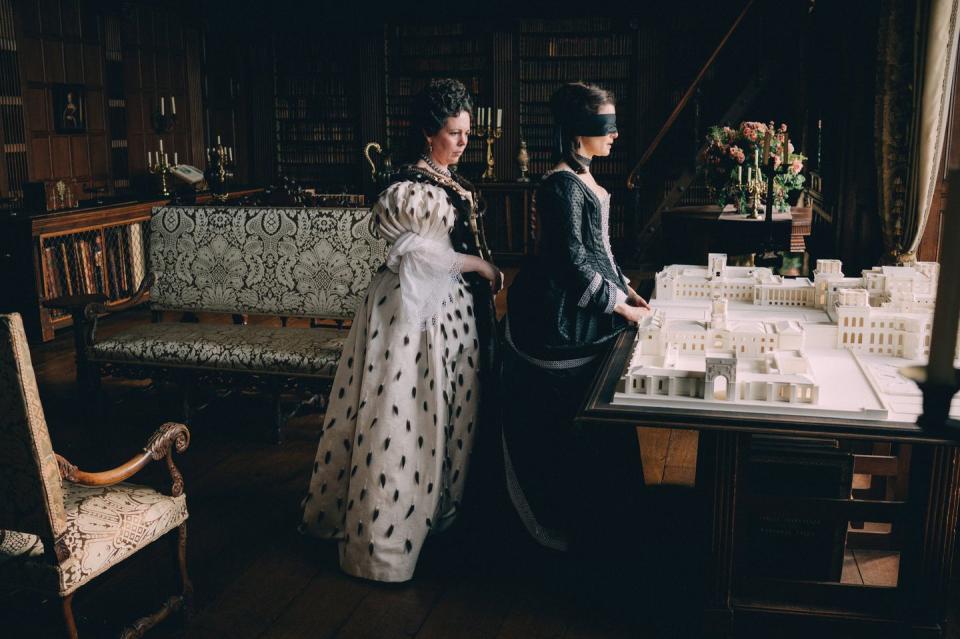
Did you look to historical sources to inform your design?
Oh, absolutely. For me, I always have to understand period first. We had things that were completely accurate. We built her carriages, and they are absolutely accurate to the period. And then of course we had these that hadn’t been invented, like wheelchairs weren’t around for another 100 years. So we created our version of a wheelchair.
I found a series of illustrations that were made later, but they were very informative. We used those to understand what would have been, and then we did what felt right for ourselves.
You also filmed in places like Hampton Court Palace, which is an actual property operated by Britain's Historic Royal Palaces. When you booked it, did they worry about the nature of the film at all, about the portrayal of the monarchy?
We did ask that question. And to their credit, they just saw it as a work of art. You know, it’s our version. I mean it’s Queen Anne, but there are big things that are missing, and big changes, and lots of license with the storytelling, and I think they saw it through that lens. Like all of Yorgos’s films, they’re in their own contained universes. So they were really great actually.
It was also complicated because [Hampton Court Palace] was open to the public. We were dressing and working with ropes like we were an exhibit. That was a first for me. I’m probably in quite a lot of tourist photos from people around the world.
('You Might Also Like',)

